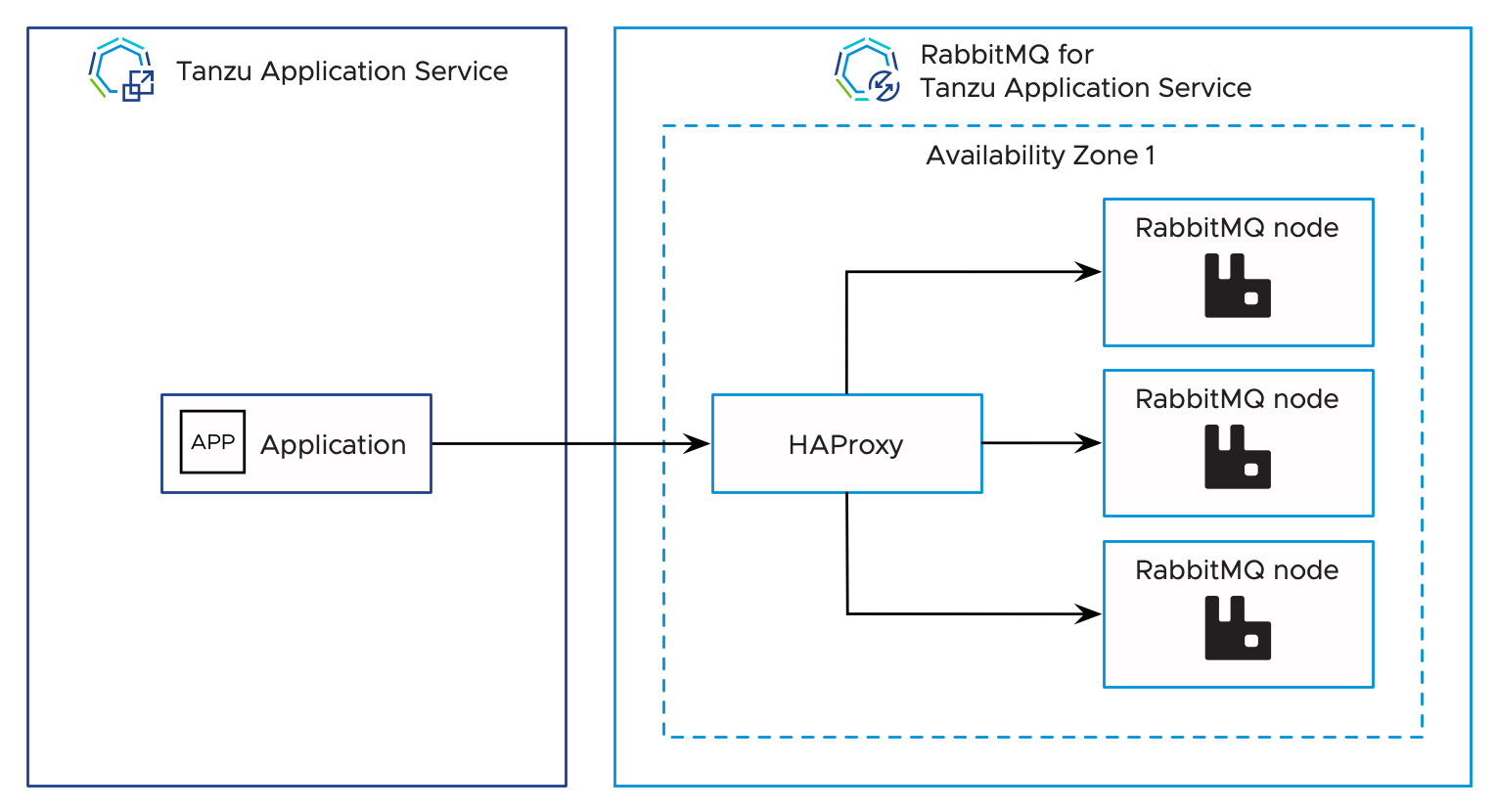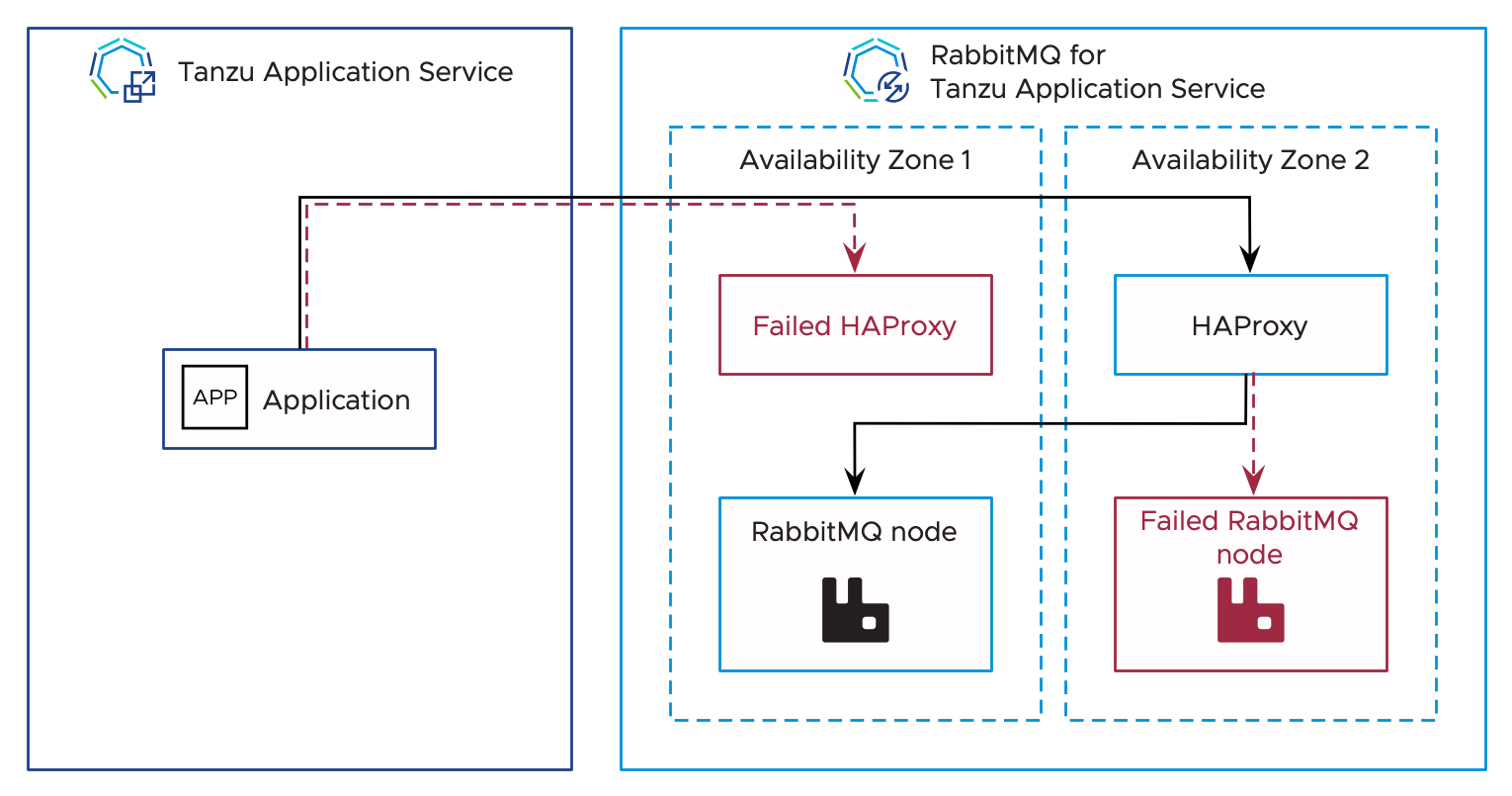This topic gives you information about the different deployment configurations for pre-provisioned VMware Tanzu RabbitMQ for Tanzu Application Service.
Default Deployment
Deploying VMware Tanzu RabbitMQ for Tanzu Application Service through Ops Manager deploys a RabbitMQ cluster of 3 nodes by default. The deployment includes a single load balancer haproxy, which spreads connections on all of the default ports for all of the shipped plug-ins across all of the machines within the cluster. The deployment occurs in a single availability zone (AZ).
The default configuration is for testing purposes only and VMware recommends that customers have a minimum of 3 RabbitMQ nodes and 2 HAProxy nodes
The following diagram shows the default Tanzu RabbitMQ for Tanzu Application Service pre-provisioned deployment.

Considerations for the Default Deployment
- Provides high availability for the RabbitMQ cluster
- Queues must be configured to be high availability as they are placed on one node by default
- Customers should decide which partition behavior is best suited to their use case. For two nodes ‘automatic’ is preferred.
- HAProxy is a single point of failure (SPOF)
- The entire deployment is in a single AZ, which does not protect against external failures from failures in hardware, networking, etc.
Recommended Deployment
VMware recommends that Tanzu RabbitMQ for Tanzu Application Service is deployed across at least two AZs. Scale RabbitMQ server nodes to an odd number that is greater than or equal to three.
Only use replication of queues where required as it can have a big impact on system performance.
The HAProxy job instance count should also be increased to match the number of AZs to ensure there is a HAProxy located in each AZ. This removes the HAProxy SPOF and provides further redundancy.
The following diagram shows the recommended Tanzu RabbitMQ for Tanzu Application Service pre-provisioned deployment. It shows that when you use this configuration, if a single HAProxy and single RabbitMQ node fail, your cluster can remain online and apps remain connected.

Upgrading to the Recommended Deployment from a Single AZ Deployment
It is not possible to upgrade to this setup from the default deployment across a single AZ.
This is because the AZ setup cannot be changed after the tile has been deployed for the first time. This is to protect against data loss when moving jobs between AZs.
Upgrading to the Recommended Deployment from a Multiple AZ Deployment
If you have deployed the tile across two AZs, but with a single HAProxy instance, you can migrate to this setup by deploying an additional HAProxy instance through Ops Manager. New or re-bound apps to the Tanzu RabbitMQ for Tanzu Application Service service instance see the IPs of both HAProxies immediately. Existing bound apps continue to work, but only by using the previously deployed HAProxy IP Address. They can be re-bound as required at your discretion.
Considerations for the Recommended Deployment
- Requires IaaS configuration for AZs ahead of deploying the Tanzu RabbitMQ for Tanzu Application Service tile.
- Application developers are handed the IPs of each deployed HAProxy in their environment variables.
- Queues must be configured to be high availability as they are placed on one node by default.
- Customers should decide which partition behavior is best suited to their use. For three or more nodes, ‘pause_minority’ is preferred.
Advanced Deployment
This deployment builds upon the above recommended deployment and so follows the same upgrade paths. This allows you to replace the use of HAProxy with your own external load balancer. You might choose to do this to remove any knowledge of the topology of the Tanzu RabbitMQ for Tanzu Application Service setup from app developers.
The diagram below shows an advanced Tanzu RabbitMQ for Tanzu Application Service pre-provisioned deployment.

Advantages:
- App developers do not need to handle multiple IPs for the HAProxy jobs in their apps
Disadvantages:
- The load balancer needs to be configured with the IPs of the RabbitMQ Nodes. These are only be known after the deployment is finished. The IPs should remain the same during subsequent deployments but there is a risk they might change.
Upgrading to the Advanced from the Recommended Deployment
It is possible to first deploy with multiple HAProxy jobs, as per the recommended deployment, and later use your own external load balancer.
This can be achieved without downtime to your apps. Follow these steps to do so:
- Configure your external load balancer to point to the RabbitMQ Node IPs.
- Configure the DNS name or IP address for the external load balancer (ELB) on the Tanzu RabbitMQ for Tanzu Application Service tile in Ops Manager.
- Deploy the changes. Any new Tanzu RabbitMQ for Tanzu Application Service service instances or any re-bound connections will use the DNS name or IP address of the ELB in their
VCAP_SERVICES. Any existing service instances continue to use the HAProxy IP addresses in theirVCAP_SERVICES - Phase the re-binding of existing apps to update their environment variables.
- After all apps are updated, reduce the instance count of the
HAProxyjob in Ops Manager to 0. - Deploy the changes.
This approach works as any existing bound apps have their VCAP_SERVICES information cached in Cloud Controller and are only updated by a re-bind request.
Downgrading from the Advanced Deployment to the Recommended Deployment
If you are currently using an external load balancer, then you can move back to using HAProxies instead.
You can achieve this by following the above steps in reverse order and re-instating the HAProxy jobs.
Resource Requirements
The following table shows the default resource and IP requirements for installing the tile:
| Product | Resource | Instances | Core | Ram | Ephemeral | Persistent | Static IP | Dynamic IP |
|---|---|---|---|---|---|---|---|---|
| RabbitMQ | RabbitMQ node | 3 | 2 | 8192 | 16384 | 30720 | 1 | 0 |
| RabbitMQ | HAProxy for RabbitMQ | 1 | 1 | 2048 | 4096 | 0 | 1 | 0 |
| RabbitMQ | Tanzu RabbitMQ for Tanzu Application Service service broker | 1 | 1 | 2048 | 4096 | 0 | 1 | 0 |
| RabbitMQ | Broker Registrar | 1 | 1 | 1024 | 2048 | 0 | 0 | 1 |
| RabbitMQ | Broker Deregistrar | 1 | 1 | 1024 | 2048 | 0 | 0 | 1 |
| RabbitMQ | Smoke Tests | 1 | 1 | 1024 | 2048 | 0 | 0 | 1 |
| RabbitMQ | RabbitMQ on-demand broker | 1 | 1 | 1024 | 8192 | 1024 | 0 | 1 |
| RabbitMQ | Register On-Demand Service Broker | 1 | 1 | 1024 | 2048 | 0 | 0 | 1 |
| RabbitMQ | Deregister On-Demand Service Broker | 1 | 1 | 1024 | 2048 | 0 | 0 | 1 |
| RabbitMQ | Delete All Service Instances | 1 | 1 | 1024 | 2048 | 0 | 0 | 1 |
| RabbitMQ | Upgrade All Service Instances | 1 | 1 | 1024 | 2048 | 0 | 0 | 1 |
| RabbitMQ | Recreate All Service Instances | 1 | 1 | 1024 | 2048 | 0 | 0 | 1 |
Notes:
- The number of
RabbitMQ Nodecan be increased if required.